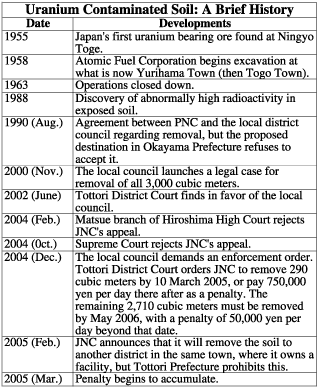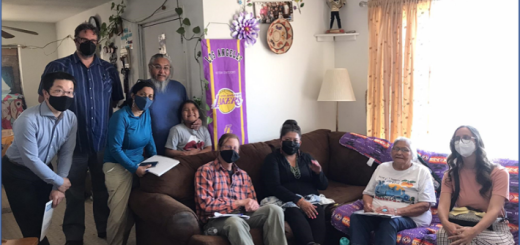US company may take uranium-contaminated soil from Japan Nuke Info Tokyo No. 107
On June 12th the Japan Nuclear Cycle Development Institute (JNC) announced that it is considering sending 290 cubic meters of ‘uranium-contaminated soil’1 to the US. This ‘soil’ has been left abandoned near Ningyo Toge2, near the border of Tottori and Okayama Prefectures for over forty years.
JNC has sounded out a private uranium refining company in the US about taking this ‘uranium-contaminated soil’ off its hands. JNC refuses to divulge the name of the US firm to whom it hopes to send the soil, but data regarding radioactivity and soil quality have already been sent to the company. JNC hopes to sign a contract this summer and send the soil overseas this year. It is expected that transport and processing will cost over 600 million yen. JNC had referred to this ‘uranium-contaminated soil’ as ‘suteishi’, which literally means ‘thrown away waste rock’. However, now that it is thinking of sending it the US to be refined, it has changed the term to ‘junkoseki’. This translates roughly as ‘quasi-ore’. No doubt JNC is eager to present its merchandise in the best possible light to potential buyers, but the reality is that it is radioactive waste and, as such, is unlikely to be welcomed by the American public.
There is a question about whether or not this uranium is covered by the Japan-US Nuclear Energy Agreement, but regardless of the judgment made on this, approval is certainly required from both the Japanese and US governments. A license is required for import to the US and information regarding this will be published on the Nuclear Regulatory Commission’s document system, ADAMS, so once a contract is signed, and before the material is sent to the US, the name of the receiving company will become public.3
The precise location of the soil is the Katamo District of Yurihama Town, Tottori Prefecture. It was originally excavated by a predecessor of what is now JNC. The immediate predecessor of that organization was the Power Reactor and Nuclear Fuel Development Corporation (PNC), but the organization that carried out the uranium excavation was an even earlier incarnation known as Atomic Fuel Corporation. In any case, all three incarnations are the same government owned organization.
 In 1988 abnormally high levels of radioactivity were discovered on the exposed soil (see history table). After a long running court case, in October 2004 the Supreme Court ruled that a total of around 3,000 cubic meters of soil must be removed. Of this, the radioactivity of around 290 cubic meters is relatively high (yearly dose exceeding the limit of 1 milli-sieverts under mining regulations). It is this which JNC is considering sending for processing and storage to a company in the US.
In 1988 abnormally high levels of radioactivity were discovered on the exposed soil (see history table). After a long running court case, in October 2004 the Supreme Court ruled that a total of around 3,000 cubic meters of soil must be removed. Of this, the radioactivity of around 290 cubic meters is relatively high (yearly dose exceeding the limit of 1 milli-sieverts under mining regulations). It is this which JNC is considering sending for processing and storage to a company in the US.
When JNC failed to take immediate action after the Supreme Court verdict, the local council sought an enforcement order. Tottori District Court ordered JNC to remove the 290 cubic meters with relatively high radioactivity by March 2005. Failing this, JNC must pay the local citizens 750,000 yen per day after this date. As at July 13th the penalty has reached 93,750,000 yen. The remaining 2,710 cubic meters must be removed by May 2006, after which JNC will incur a further penalty of 50,000 yen per day. JNC is a government corporation and 80% of its budget comes from the government, so this penalty is being funded by tax payers’ money.
In November last year JNC announced that as a temporary measure it would transfer the soil to another site about a kilometer away in a different district, but still in Yurihama Town. However, this plan met strong local opposition and Tottori Prefecture blocked the move under the Prefectural Natural Parks Ordinance. In the whole Ningyo Toge area there is 420,000 cubic meters of abandoned material excavated during the development of this uranium mine. Furthermore, elevated levels of radioactivity have been found in paddy fields etc. in the area.
In the light of the vexed history surrounding this case, JNC’s latest plan can be seen as a desperate attempt to pass the problem onto someone else, the further away the better. However, if public opposition in the US blocks the plan, JNC will be back where it started and the old adage will be proven true once again, namely that the nuclear industry is like a house without a toilet, and nothing smells fouler than radioactive waste.
Philip White (NIT Editor)
1. The soil in question was excavated in order to get to a uranium ore seam. Apparently the ore from the seam itself has been removed, but the soil etc. through which they bored to get to the seam was abandoned, despite the fact that it contained elevated levels of uranium. The purpose of the boring was to ascertain whether a viable uranium mine could be established. As it turned out, the quality of the uranium ore was low, so the mine and the excavated material were abandoned.
2. ‘Toge’ is a Japanese word meaning ‘mountain pass’.
3. Since publishing this article we have been in communication with US groups about the matter. Although we don’t have a complete picture of the requirements for US government involvement and for approvals from US regulators, it seems that this shipment fell through the loopholes of the regulatory system. In the end, the name of the US company only became known as a result of analysis of documents released under Japanese freedom of information legislation.


